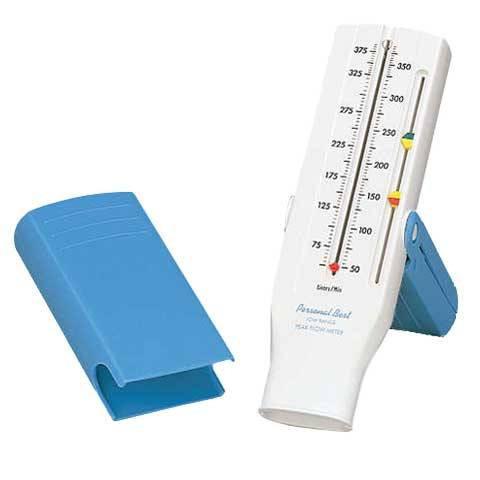
The numbers should all be very close together if you're doing it right each time. Repeat steps 1 to 7 two more times as soon as you can after you've taken a few normal breaths.If not, write down the number on the meter at which the marker now rests (spring system) or that shows on your the screen (digital), if not logged electronically. If you coughed, your tongue got in the way, or you didn't get a good seal, repeat these steps and discard that reading.Blow air out as hard and as fast as you can in one breath for no more than one second.While holding your breath, put the meter's mouthpiece in your mouth, making sure that your tongue is underneath the mouthpiece and your lips are closed tightly to create a seal around it.Inhale deeply, filling up your lungs as much as you can.Attach the mouthpiece if it's not already connected.If you're using a digital meter, turn it on. If you're using a meter with a spring system (not digital), make sure the marker on your meter is at 0 or the lowest number.“Table of Normal Peak Flow Values.” Partners Asthma Center. “The Peak Flow Meter.” Health Information Publications. “Peak Flow Meter.” Mayo Foundation for Medical Education and Research. Asthma, chronic obstructive pulmonary disorder, and emphysema are some of the conditions that will affect peak flow meter readings. Any lung condition that decreases air flow will result in abnormal readings. There are several causes of abnormal peak flow meter readings. Emergency medical treatment is usually required at this stage. Anything below 50% of the baseline reading is in the red peak flow zone. This zone indicates a worsening in lung function. When the readings are between 50 and 80% of the baseline reading, they are categorized in the yellow peak flow zone. These readings are categorized in the green peak flow zone, which indicates stable lung function. Normal readings of peak flow meters are within 80-100% of the baseline reading. Check the charts below for normal peak flow values ( click on images to enlarge).

For example, a 30 year old male that is 5'10'' tall should have a reading close to 622 liters per minute. Normal readings of peak flow meters depend on a person’s age, sex, and height. Each reading is compared with the initial or baseline reading, which is taken when you are breathing without any symptoms. Specifically, the unit of the peak flow meter scale is liters per minute. Results of a Peak Flow Meter TestĪ peak flow meter displays the result as a unit of volume per a unit of time. If any saliva or water enters the meter, the reading could be affected. It is important to only blow air into the meter. Record the measurement and repeat for a third time. So, reset the scale to zero, take a deep breath, and blow once again into the meter. To accurately measure the peak expiratory flow, which is the maximum rate of exhalation, a total of three measurements is recommended. Take a deep breath and blow as hard as you can into the peak flow meter. To use the peak flow meter, set the scale on the meter to zero and hold the meter firmly. Most peak flow meters are cylindrical in shape, but there are a few digital peak flow meters that are more compact. It is small enough to fit in the palm of the hand. The peak flow meter consists of a tube that you blow into and a scale that indicates how much air was expelled from the lungs in a given period of time.



When several readings are taken over a period of weeks or months, one can determine if the lungs are stable or getting worse. It measures the rate at which air is expelled from the lungs. A peak flow meter is a diagnostic tool used to monitor how well the lungs are functioning.


 0 kommentar(er)
0 kommentar(er)
